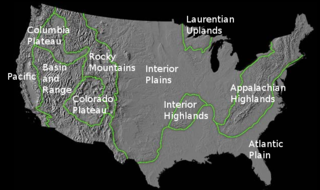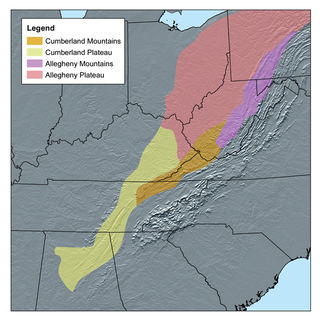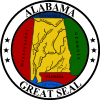Related Research Articles

The geography of Alabama describes a state in the Southeastern United States in North America. Alabama is 30th in size and borders four U.S. states: Mississippi, Tennessee, Georgia, and Florida. It also borders the Gulf of Mexico.

The term "United States", when used in the geographical sense, is the contiguous United States, the state of Alaska, the island state of Hawaii, the five insular territories of Puerto Rico, Northern Mariana Islands, U.S. Virgin Islands, Guam, and American Samoa, and minor outlying possessions. The United States shares land borders with Canada and Mexico and maritime borders with Russia, Cuba, the Bahamas, and other countries, in addition to Canada and Mexico. The northern border of the United States with Canada is the world's longest bi-national land border.

The Appalachian Mountains, often called the Appalachians, are a system of mountains in eastern North America. The Appalachians first formed roughly 480 million years ago during the Ordovician Period. They once reached elevations similar to those of the Alps and the Rocky Mountains before experiencing natural erosion. The Appalachian chain is a barrier to east–west travel, as it forms a series of alternating ridgelines and valleys oriented in opposition to most highways and railroads running east–west.

A seismic hazard is the probability that an earthquake will occur in a given geographic area, within a given window of time, and with ground motion intensity exceeding a given threshold. With a hazard thus estimated, risk can be assessed and included in such areas as building codes for standard buildings, designing larger buildings and infrastructure projects, land use planning and determining insurance rates. The seismic hazard studies also may generate two standard measures of anticipated ground motion, both confusingly abbreviated MCE; the simpler probabilistic Maximum Considered Earthquake, used in standard building codes, and the more detailed and deterministic Maximum Credible Earthquake incorporated in the design of larger buildings and civil infrastructure like dams or bridges. It is important to clarify which MCE is being discussed.

The richly textured landscape of the United States is a product of the dueling forces of plate tectonics, weathering and erosion. Over the 4.5 billion-year history of our Earth, tectonic upheavals and colliding plates have raised great mountain ranges while the forces of erosion and weathering worked to tear them down. Even after many millions of years, records of Earth's great upheavals remain imprinted as textural variations and surface patterns that define distinctive landscapes or provinces.

The Cumberland Plateau is the southern part of the Appalachian Plateau in the Appalachian Mountains of the United States. It includes much of eastern Kentucky and Tennessee, and portions of northern Alabama and northwest Georgia. The terms "Allegheny Plateau" and the "Cumberland Plateau" both refer to the dissected plateau lands lying west of the main Appalachian Mountains. The terms stem from historical usage rather than geological difference, so there is no strict dividing line between the two. Two major rivers share the names of the plateaus, with the Allegheny River rising in the Allegheny Plateau and the Cumberland River rising in the Cumberland Plateau in Harlan County, Kentucky.
The Highland Rim is a geographic term for the area in Tennessee surrounding the Central Basin. Nashville is largely surrounded by higher terrain in all directions.

The New Madrid Seismic Zone, sometimes called the New Madrid Fault Line, is a major seismic zone and a prolific source of intraplate earthquakes in the Southern and Midwestern United States, stretching to the southwest from New Madrid, Missouri.

A geologic province is a spatial entity with common geologic attributes. A province may include a single dominant structural element such as a basin or a fold belt, or a number of contiguous related elements. Adjoining provinces may be similar in structure but be considered separate due to differing histories.

The 2003 Alabama earthquake took place on April 29 at 3:59 A.M. Central Daylight Time eight miles (13 km) east-northeast of Fort Payne, Alabama. The number of people who felt this quake was exceptionally high as the earthquake could be felt in 11 states across the East Coast and as far north as southern Indiana. The earthquake was strongly felt throughout metropolitan Atlanta. The Georgia Building Authority was called out to inspect the historic Georgia State Capitol in downtown Atlanta and other state-owned buildings, but found no problems. However, this is not out of the ordinary as earthquakes east of the Rocky Mountains can be felt several times the area felt on West Coast earthquakes. The earthquake was given a magnitude 4.6 on the moment magnitude scale by the USGS and reports of the duration of the shaking range from 10 seconds to as long as 45 seconds. It is tied with a 1973 earthquake near Knoxville, Tennessee as the strongest earthquake ever to occur in the Eastern Tennessee Seismic Zone, which is the second most active seismic zone east of the Rocky Mountains, with the New Madrid Seismic Zone the most active.

The Geology of Georgia consists of four distinct geologic regions, beginning in the northwest corner of the state and moving through the state to the southeast: the Valley and Ridge region, also known as the Appalachian Plateau; the Blue Ridge; the Piedmont and the Coastal Plain. The Fall Line is the boundary between the Piedmont and the Coastal Plain.

The Geology of Pennsylvania consists of six distinct physiographic provinces, three of which are subdivided into different sections. Each province has its own economic advantages and geologic hazards and plays an important role in shaping everyday life in the state. They are: the Atlantic Coastal Plain Province, the Piedmont Province, the New England Province, the Ridge and Valley Province, the Appalachian Plateau Province, and the Central Lowlands Province.
The Virginia Seismic Zone in the U.S. state of Virginia covers about 8,000 square kilometres (3,100 sq mi) in the Piedmont province. Earthquakes in the state are irregular and rarely reach over 4.5 in magnitude.
A physiographic province is a geographic region with a characteristic geomorphology, and often specific subsurface rock type or structural elements. The continents are subdivided into various physiographic provinces, each having a specific character, relief, and environment which contributes to its uniqueness. The physiographic provinces are then subdivided into smaller physiographic sections.
The Eastern Tennessee Seismic Zone (ETSZ), also known as the East Tennessee Seismic Zone and the Southern Appalachian Seismic Zone, is a geographic band stretching from northeastern Alabama to southwestern Virginia that is subject to frequent small earthquakes. The ETSZ is one of the most active earthquake zones in the eastern United States.

The Ramapo Fault zone is a system of faults between the northern Appalachian Mountains and Piedmont areas to the east. Spanning more than 185 miles (298 km) in New York, New Jersey, and Pennsylvania, it is perhaps the best known fault zone in the Mid-Atlantic region, and some small earthquakes have been known to occur in its vicinity. Recently, public knowledge about the fault has increased, especially after the 1970s, when the fault's proximity to the Indian Point nuclear plant in New York was noted.

The 1916 Irondale earthquake struck in the north–central region of the U.S. state of Alabama on October 18. The strongest earthquake in state history, it registered an estimated Richter scale magnitude of 5.1 and resulted in extensive, but minor damage. This damage, limited to Shelby and Jefferson counties, reached its maximum severity near the epicenter in the city of Irondale, including cracked windows, fallen chimneys, and dried-up wells. While there were no fatalities, the earthquake spawned widespread panic, sending alarmed workers from tall buildings.

Michael Tuomey was the State Geologist of South Carolina from 1844 to 1847, and the first State Geologist of Alabama, appointed in 1848 and serving until his death. His early descriptions and maps of the Birmingham District's unique coincidence of mineral resources for the making of steel opened the way for the early industrial development of the state.

An earthquake measuring 4.4 MW on the moment magnitude scale struck 6.8 miles (10.9 km) north-northeast of Decatur, Tennessee in the eastern part of the state on December 12, 2018 at 4:14 a.m. Eastern Standard Time. The earthquake occurred at a depth of 9.0 kilometres (5.6 mi). The earthquake occurred along the Eastern Tennessee Seismic Zone (ETSZ), a geographic band stretching from northeastern Alabama to southwestern Virginia that is subject to frequent small earthquakes. The earthquake was felt throughout the Southeast, primarily in eastern Tennessee and the Atlanta metropolitan area. While relatively minor, this earthquake was the largest to occur on the ETSZ since the 4.6 MW 2003 Alabama earthquake, the third largest to have been recorded in the area, becoming the fourth largest earthquake recorded in the region. Robert Sanders from the U.S. Geological Survey told WSB-TV that aftershocks would be possible throughout the day after the quake.

The 2020 Sparta earthquake was a relatively uncommon intraplate earthquake that occurred near the small town of Sparta, North Carolina, on August 9, 2020 at 8:07 am local time. The earthquake had a moment magnitude of 5.1, and a shallow depth of 7.6 kilometres (4.7 mi). Shaking was reported throughout the Southern, Midwestern, and Northeastern United States. It was the strongest earthquake recorded in North Carolina in 104 years, the second-strongest in the state's history, and the largest to strike the East Coast since the 2011 Virginia earthquake.
References
- 1 2 3 4 Archived 2007-05-17 at the Wayback Machine USGS; Geologic Provinces of the United States: Records of an Active Earth
- ↑ A Tapestry of Time and Terrain: The Union of Two Maps – Geology and Topography; State Boundaries; Alabama
- 1 2 3 Archived 2008-08-10 at the Wayback Machine Geologic Survey of Alabama; Geologic Map; Northwest Section Legend
- ↑ "East Gulf Coastal Plain Ecoregional Plan" (PDF). The Nature Conservancy. 2001. Retrieved 15 November 2013.[ permanent dead link ]
- 1 2 3 "Archived copy". Archived from the original on 2006-05-15. Retrieved 2008-01-30.CS1 maint: archived copy as title (link) A Tapestry of Time and Terrain: The Union of Two Maps – Geology and Topography; Physiographic Regions
- ↑ Archived 2008-07-25 at the Wayback Machine Discovering Alabama; Teacher’s Guide, Geologic History
- 1 2 Archived 2008-10-06 at the Wayback Machine Faulk, Kent. Alabama isn't immune to earthquakes, scientists say; Birmingham News; April 20, 2008
- ↑ Archived 2009-05-15 at the Wayback Machine USGS; Earthquake Hazards Program; Regional Information; U.S. Earthquake Information by State; Alabama
- ↑ Archived 2009-05-09 at the Wayback Machine USGS; Earthquake Hazards Program; Regional Information; U.S. Earthquake Information by State; Alabama; Largest Earthquake in Alabama
- ↑ Geological Survey of Alabama; Geologic Hazards Program; Earthquakes
- ↑ Archived 2009-08-09 at the Wayback Machine USGS; Alabama; Seismic Hazard Map
- ↑ Geological Survey of Alabama
- ↑ Alabama Oil and Gas Board
- ↑ Smith, Eugene Allen (October 1897) "Sketch of the Life of Michael Tuomey". American Geologist. Vol. 20, p. 207
- ↑ Fazio, Michael W. (2010) Landscape of Transformations: Architecture and Birmingham, Alabama. Knoxville, Tennessee: University of Tennessee Press ISBN 978-1-57233-687-2
- ↑ Earth Impact Database. Retrieved on April 24, 2008
